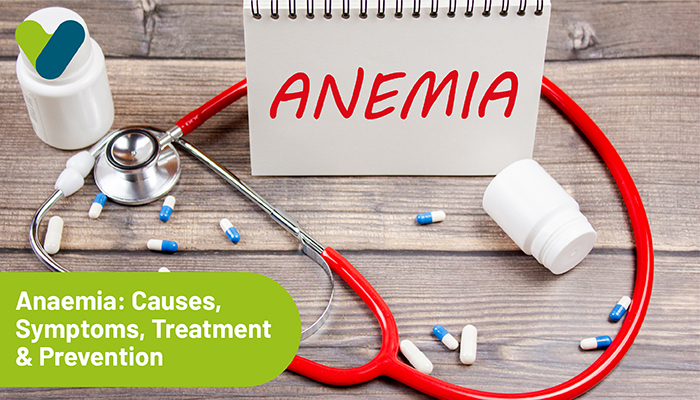Table of Contents
Anaemia is a significant global public-health problem that primarily affects children and pregnant women. According to the WHO, 40% of pregnant women and 42% of children under the age of five worldwide are anaemic.
Let us find out more about anaemia, including its symptoms, causes, risk groups, treatment, and prevention.
An Overview of Anaemia
Anaemia is a common blood disorder in which your haemoglobin concentration or red blood cell (RBC) count decreases. Physiologically, a certain concentration of haemoglobin is required in your body to transport oxygen to your tissues and cells of the body to provide energy. If you have abnormal amounts of or very few RBCs or insufficient haemoglobin, your blood's capacity to transport oxygen to the body's tissues will be reduced (in an anaemic condition), and your body will not be able perform its functions efficiently.
There are various types of anaemia, each of which has a distinctive cause. Some types of anaemia are temporary and mild, while others can last a lifetime. Anemia can be fatal if left untreated.
Signs & Symoptoms of Anaemia
The most noticeable anaemia symptom is fatigue or feeling too exhausted to carry out your daily activities. Other signs and symptoms may include:
- Dyspnoea (shortness of breath): This is the sensation of being unable to take a deep breath
- Feeling lightheaded or jittery on your feet
- Arrhythmia (rapid or irregular heartbeat): This feels like your heart is skipping or racing beats
- Pulsatile tinnitus (pounding sound in your ear): This refers to a whooshing sound that may be intermittent and can be felt in one of your ears
- Headache: Headaches can be caused by anaemias occurring due to low haemoglobin levels or iron deficiency anaemia
- Yellow or pale-looking skin
- Chest pain may feel as if something is squeezing or pressing on your chest
Causes of Anaemia
There are numerous causes of anemia. Some causes include:
- Dietary deficiency: This indicates deficiency of folic acid, iron, or vitamin B12 in the diet.
- Malabsorption: This includes abnormalities in the body's capacity to absorb nutrients from food; an example of this condition is coeliac disease.
- Genetic abnormalities: These involve abnormal production of haemoglobin, which can result from conditions such as sickle cell disease or thalassemia, or abnormalities in the enzymes that are involved in the production of haemoglobin, which can originate from porphyria.
- Autoimmune disorders: In these conditions, the RBC’s life span is reduced due to increased immune system clearance. Examples of this condition include autoimmune haemolytic anaemia or thyroid disease.
- Kidney disorders: This condition involves reduced erythropoietin production.
- Chronic inflammatory disorders: Chronic inflammation, such as arthritis, can impair the body's ability to use iron.
- Bone marrow disorder: In this condition, RBC production decreases due to a bone-marrow-related disease, such as in leukaemia (blood cancer).
- Direct blood loss: This occurs as a result of surgery, blood donation, trauma, gastric ulcers, menstrual periods, and intestinal polyps.
- Toxins or medicines: Toxins like alcohol can directly harm bone marrow, and some medications can impair the bone marrow function.
- Pregnancy: This is a time of increased need of nutrition.
- Artificial heart valves: These can impact red blood cells, thereby shortening their natural life.
- Infectious diseases: Anaemia, in infections, is frequently caused by multiple mechanisms, such as in malaria.
High-risk groups for Anaemia
- Anaemia is highly likely to occur in certain people, including:
- Women who are menstruating
- Women who are pregnant or breastfeeding
- Babies, especially premature babies
- Adolescents going through puberty
- People who follow a vegan diet or are vegetarians
- People suffering from stomach ulcers, cancers, and other chronic illnesses (especially kidney disorders and those on dialysis treatment)
- People who follow crash diets
- Sports people
- Individuals with a family history of a hereditary anaemia, including sickle cell anaemia
- People over the age of 65, who are highly prone to age-related anaemia
Investigations to Detect Anaemia
Your doctor will ask you questions regarding your symptoms. Because anaemia occurs when you lack a sufficient number of healthy RBCs, blood tests will be performed to evaluate your RBCs.
-
Complete blood count (CBC): This test is used by doctors to examine all cells of your blood, with an emphasis on red blood cells. They count your RBCs and assess the size and shape of your RBCs.
-
Peripheral blood smear: Your RBCs are examined under a microscope by healthcare professionals.
Different Types of Anaemia
There are several types of anaemia, each of which causes a decline in red blood cell levels.
Nutritional Anaemia
- Pernicious Anaemia: This is an auto-immune disorder that prevents your body from absorbing vitamin B12. It is also one of the factors that causes vitamin B12 deficiency.
- Iron-deficiency Anaemia: This anaemia arises when your body lacks a sufficient amount of iron to make haemoglobin, which is a substance found in the RBCs and is responsible for the transport of oxygen all over your body.
- Megaloblastic Anaemia: This anaemia is caused by a lack of vitamin B9 (folate) and/or vitamin B12.
Inherited Anaemias
- Sickle cell anemia: This anaemia changes the shape of your red blood cells, transforming them from round, flexible discs that block blood flow into rigid and gluey sickle cells.
- Fanconi anaemia: This is an infrequent blood disorder, and which anaemia is one symptom of this disorder.
- Diamond-Blackfan anaemia: This hereditary disorder prevents your bone marrow from producing sufficient RBCs.
Anaemias caused by atypical (abnormal) red blood cells
- Haemolytic anaemia: This anaemia occurs when your RBCs degrade or die at a faster rate than usual.
- Aplastic anaemia: This condition occurs when your bone marrow fails to produce sufficient red blood cells.
- Autoimmune haemolytic anaemia: It occurs when your body's immune system attacks red blood cells.
- Sideroblastic anaemia: This condition is characterised by a lack of red blood cells as well as an excess of iron in the body.
- Macrocytic anaemia: In this condition, the bone marrow produces abnormally large RBCs.
- Microcytic anaemia: This occurs when your RBCs lack haemoglobin and become smaller than usual.
- Normocytic anaemia: In this type of anaemia, you have fewer than usual red blood cells, and those RBCs do not have the normal amount of haemoglobin.
Different Types of Anaemia
Any anaemia treatment focuses on the underlying problem and therefore should target the root cause. The symptoms of anaemia range from mild to severe and from simple to fatal.
If the anaemia is caused by a highly complicated cause, specialists such as a haematologist or a gastroenterologist may be consulted.
The treatment course for anaemia can also be influenced by the severity of the condition or other factors impacting the patient’s health, such as age or the rate at which anaemia develops.
To treat anaemias caused by abnormal RBCs, such as aplastic anaemia or haemolytic anaemia, healthcare providers may use medications such as immunosuppressants or treatments such as blood transfusions.
Can I Avoid Getting Anaemia?
Some types of anaemia, such as haemolytic anaemia, sickle cell anaemia, and aplastic anaemia, cannot be avoided. Individuals with chronic illnesses who are at a risk of developing anaemia should be on the watch for anaemia symptoms. A healthy diet that is rich in iron, folate, and vitamin C can also help you avoid nutritional anaemia.
Conclusion
Anemia occurs when you do not have sufficient RBCs or when your RBCs are not functioning properly. Some individuals are born with anaemia, but the majority of people who have anaemia develop it over time. That is why it is critical to monitor your body's changes. For instance, you must have faced times when you got exhausted. However, if you have been feeling utterly exhausted over several days despite getting plenty of rest, consult your doctor. Anemia is usually a short-term problem that can be managed by modifying your nutrition or taking supplements. Anemia, if left untreated, can lead to serious medical problems.


